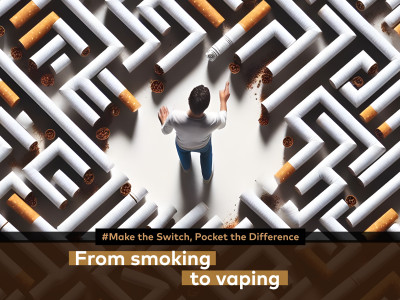On a positive note, “this device can analyse vapour extract samples from cigarettes and water samples in 5 min for less than $1.00.” Offering a low cost and highly portable solution to environmental testing is a welcome addition, should it prove to work effectively. It is a pity that this particular study repeats errors and serves up the equivalent of the computer science phrase: garbage in, garbage out.
Despite being hidden behind a paywall, we have seen the full study. It describes the collection of vape samples very poorly: “To keep experimental conditions representative and relevant for vaping usage by smokers we extracted 100 puffs and smoke from 5 tobacco cigarettes for comparison. Vaping anywhere from 75 to 175 puffs from e-cigarettes is equivalent on average to 5−6 tobacco cigarettes per day. Approximately 15−30 puffs from an e-cigarette is considered equivalent to smoke from one tobacco cigarette.”
Then, from a very weak explanation of how samples were collected, the study makes some absolutely ludicrous claims: “Most chemicals in tobacco cigarettes and e-cigarettes are similar to slightly lower concentrations reported for e-cigarettes.” It’s confused and (ultimately) wrong.
“Usually, contents of e-cigarettes are loaded into a cartridge and used with a battery operated inhalation device that heats and converts a nicotine solution with additives into an aerosol.” Usually? Only if your sole source of knowledge lies rooted in one paper produced by Stanton Glantz!
Kadimisetty told journalists: “Some people use e-cigarettes heavily because they think there is no harm. We wanted to see exactly what might be happening to DNA, and we had the resources in our lab to do that. From the results of our study, we can conclude that e-cigarettes have as much potential to cause DNA damage as unfiltered regular cigarettes.”
His statement was included in a University of Connecticut press release declaring: “UConn researchers found that e-cigarettes loaded with a nicotine-based liquid are potentially as harmful as unfiltered cigarettes when it comes to causing DNA damage.”
Clearly, if toxin levels were almost identical, the research team experienced cross-contamination or ran the vape collection procedure in a manner wholly unreflective of actual vaping conditions.
The United Kingdom Vaping Industry Association pointed out the obvious: “The public health research in the UK is very clear. Public Health England has found vaping is likely to be 95% less harmful than smoking. The Royal College of Physicians found that vaping did not exceed 5% of the harm from smoking. Earlier this year, Cancer Research UK stated that not only is vaping a safer alternative to tobacco, its long-term harmful effects appear to be minimal. Even though this study certainly warrants further research, the University admits that the device they used to measure toxicity is new and not as comprehensive as current techniques of measurement.”
Cynics might suggest that this study was more about obtaining media coverage and raising brand awareness than contributing productively to the body of ecig-related research. The same cynics might suggest that this is yet another group of scientists seeking to profit on the back of attacking harm reduction.
“What we developed is very cheap to make, efficient, and can be used by almost anyone,” said senior researcher James Rusling. His lab specialises in producing ‘labs on a chip’ to the pharmaceutical industry, and Rusling went on to suggest that this new chip could be used in monitoring or detection applications, and as part of drug development.
Photo Credit:
Images from the University of Connecticut
Dave Cross
Journalist at POTVDave is a freelance writer; with articles on music, motorbikes, football, pop-science, vaping and tobacco harm reduction in Sounds, Melody Maker, UBG, AWoL, Bike, When Saturday Comes, Vape News Magazine, and syndicated across the Johnston Press group. He was published in an anthology of “Greatest Football Writing”, but still believes this was a mistake. Dave contributes sketches to comedy shows and used to co-host a radio sketch show. He’s worked with numerous vape companies to develop content for their websites.
Join the discussion
Parliament Fears Two
The Department for Environment, Food and Rural Affairs faced questions from a Conservative MP and, oddly, a member of the Department for Environment, Food and Rural Affairs
Harm Reduction For The Rich
The United Kingdom risks becoming a harm reduction country only for the wealthy, according to Michael Landl of the World Vapers’ Alliance
Sacrificing Health For 2p Cut
Tory Government alienates vaping voters with its mission to cut tax by an unaffordable 2p to attract voters by placing a tax on vape products in the forthcoming budget
Scotland Announces Single-Use Vape Action
A ban on the sale and supply of single-use vapes in Scotland is due to come into effect on 1 April 2025, under proposed legislation published today












